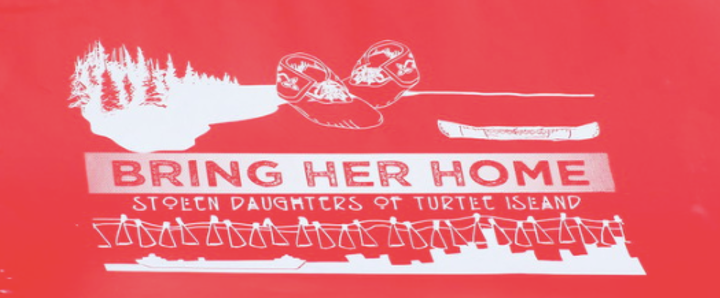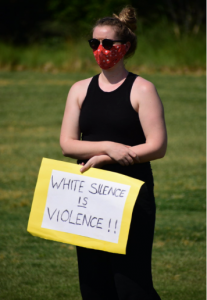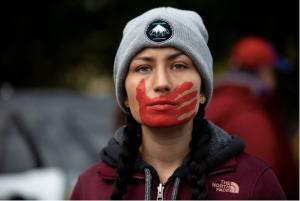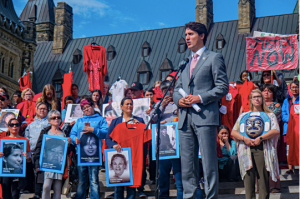7 Missing and Murdered Indigenous Women (MMIW) in Canada
Sara Doesburg and Jaslyne Golaz
The cases of missing and murdered Indigenous women (MMIW) have been hidden from the broader society since the beginning of colonialism. The purpose of this chapter is to bring you through our process of learning about the multifaceted dynamics involved in the crisis of MMIW, to analyse this topic’s connection to sport, and to highlight key areas of social change. We hope that as you learn alongside us you will feel motivated to take action in solidarity with Indigenous women to bring them justice.

The exact number of Indigenous women who have been murdered or are missing in Canada is unknown, however, it is estimated to be over 4000 women with half of the murder cases remaining unsolved (Moeke-Pickering et al., 2018). Canadian Indigenous women are 4.5 times more likely to be murdered than non-Indigenous women. They make up 25% of national female homicide victims, despite representing only 4% of the population (Saramo, 2016). Not only is the prevalence of murdered Indigenous women disproportionately high, the rate of charges against the perpetrators in these crimes is about 30% lower than it is for non-Indigenous victims. Chances are you have not heard these statistics before and were unaware this was even an issue in Canada. And, if like us, you are recently learning about this, you are probably just as outraged as we are.
We must ask ourselves several questions in order to understand how we have come to this point. Firstly, what has led to this becoming an issue in the first place? Why is MMIW such a silent issue within Canada? And finally, what role does law enforcement have in the low conviction rates and the disproportionately high number of unsolved cases of MMIW?
Settler Colonialism and the Indian Act
To understand the crisis of MMIW we need to go back to the roots of where the hardships for Indigenous women and girls began. Traditionally Indigenous women held very respected leadership roles in their communities and were central to the family as the head of the household. Indigenous women were not dependent on men for their economic status, and a family’s inheritance was often passed down through the women in the family (The Canadian Research Institute for the Advancement of Women [CRIAW], 2016). Settler colonialism introduced a patriarchal system which was forced on Indigenous peoples through policies and laws. The Indian Act of 1876 introduced policies which were detrimental to Indigenous peoples and was discriminatory against women (Eberts, 2014). For example, only men were given leadership of Indigenous reserves removing women from their positions of power. Additionally, the state would only recognize someone as a “registered Indian” if they were the descendant of or were married to an Indigenous man. If an Indigenous woman married a non-Indigenous man she would be stripped of her status and displaced from the safety of her community and lands (Eberts, 2014). These policies significantly impacted women’s roles within their communities and removed women from the safety of their lands leaving them vulnerable to violence (CRIAW, 2016). The sex discrimination of the Indian Act has been identified as the root cause creating the conditions which have led to the high levels of violence against Indigenous women (Brodsky, 2016). All of these policies were only recently eliminated from the Indian Act in 2019, so why did it take so long for this change to occur?
Stereotypes and Attitudes Leading to Silence

Settler colonialism also introduced sexualized stereotypes and racist attitudes upon Indigenous women which served to dehumanize them and continue to influence Canadian society today. Indigenous women are often portrayed as prostitutes, street people and addicts so when they are victimized the blame is often placed on them, however, the context of their differing socio-economic status is often ignored (Moeke-Pickering et al., 2018). Crimes against Indigenous women are frequently under reported in the media which contributes to normalizing the perspective that crimes against Indigenous peoples do not matter (Palmater, 2016). Turning a blind eye to what is happening also allows settlers to continue to see themselves as good by not acknowledging their role in what is currently happening to Indigenous women (Eberts, 2014). The ongoing racist stereotypes and attitudes against Indigenous women play a large role in the Canadian silence of the undeniable problem of MMIW. I challenge you to have a conversation with those around you about MMIW and pay close attention to their words and attitudes on this issue.
Police Under Protection & Sexualized Violence
Racism and stereotypes about Indigenous women influence settlers to ignore the violence against Indigenous women and reflect the viewpoint that Indigenous women’s lives have less value than white women’s lives. Even police in Canada hold racist and sexualized attitudes towards Indigenous women, which can be seen through their outright targeting of Indigenous women and girls with violence, the refusal to protect them or to locate missing individuals, or to investigate, and charge the killers (Palmater, 2016). The magnitude of racism and sexualized violence in police forces across Canada is shocking, but not nearly as shocking as it would be if the true number of all the victims, including those who never came forward, those turned away by authorities, and those who filed complaints that were ignored, were revealed.
The impact of the negligence within police forces in Canada hits home when you learn about individual cases. For instance, a 15-year-old girl named Tina Fontaine from the Sagkeeng First Nation was found dead after repeated encounters and interactions, right before her death, with the police and child services who could have prevented her murder. The police failed to protect Tina and missed key opportunities to prevent her death. To learn more about this case read this article . It is the job of the police to protect all, so why is this group excluded?
Canadian police’s history of sexual violence against Indigenous women is exemplified in the following case. In 2011, an RCMP constable arrested a woman at a party for “intoxication”, took her to a cell and came back later in his regular clothes to take her to his home with the intent of having a personal relationship with her. The other officers encouraged him, and his senior officer even said, “you arrested her, you can do whatever the fuck you want to do” (Palmater, 2016, p. 278). This incident is horrendous, and it is difficult to believe that law enforcement would condone and participate in such behaviour, but tragically it did happen.
Not only are the police not protecting Indigenous women from violence, but they are also part of the population who is subjecting them to further violence thus magnifying the crisis of MMIW. If all women in Canada were treated this way by police, do you think this would still be a silent issue?
Bringing Awareness Through Sport and the Media
A lot of noise and action has been focused on the issue of MMIW at the community level, and it has been able to cut through the silence. Athletes across North America have been participating in marathons to raise awareness for MMIW bringing some much needed attention. In Canada, an Indigenous man known as Caribou Legs completed a cross country marathon from Vancouver to Newfoundland to raise awareness for MMIW in 2016.

During his journey Caribou Legs said he hoped to raise the conscious level of Canadians and create dialogue on MMIW. His efforts gained a lot of attention from the media; they followed his marathon and spread his message (Robinson-Desjarlais, 2016). Another example of attention to MMIW insport is demonstrated by a high school track athlete who made a bold statement when she ran her race with a red hand painted over her mouth, and the letters “MMIW” painted on her leg. The red hand symbolizes the silencing of Indigenous voices on the issues of MMIW and is used as a sign of activism and solidarity. A photographer captured this powerful moment, and his photo went viral gaining traction for the MMIW movement within the media (Reneau, 2019).
Many people are shocked when they first learn about MMIW since it has largely been a silent issue that has not received the attention and outrage it deserves. Sport serves as a powerful platform to reveal the atrocities of MMIW to the masses, in an attempt to bring murdered women and girls the justice they deserve. A large portion of the activism has been to push for social change by putting pressure on the government to begin a National Inquiry on MMIW (Moeke-Pickering et al., 2018).
National Inquiry
Despite many activists calling for social change, the Harper government downplayed the need for action on MMIW. Harper himself went so far as to say, “we think the issue has been studied to death,”, and “it really isn’t high on our radar, to be honest.” (Saramo, 2016, p. 208). The fact that Canada’s own prime minister was dismissing MMIW just shows how deep the problem lies.

Shortly after the Trudeau liberal government was elected, they announced the National Inquiry into Missing and Murdered Indigenous Women and Girls, with the Final Report being completed on June 3, 2019 (Saramo, 2016; Brant, 2017). The National Inquiry included 231 individual calls for justice that are aimed at governments, institutions, industries, social service providers, and all Canadians. The report concluded that settler colonialism, and the deliberate and ongoing human rights violations against Indigenous peoples is the root cause of the violence against Indigenous women and is what lead to this Canadian genocide (Forani, 2019).
Despite the extensive recommendations outlined in the Final Report on policing in Canada, there has yet to be a national strategy developed by the Canadian Association of Chiefs of Police in carrying out these recommendations (Stefanovich, 2020). This is concerning since it is essential that the research that went into the National Inquiry be translated into tangible action in order for there to be substantial progress for MMIW.
What Now?
While the National Inquiry is a step in the right direction, we need to use this momentum to invoke tangible change. The structures of colonialism within Canadian society that exist within government policies and in law enforcement need to be dismantled. We need to challenge and bring awareness to the stereotypes and attitudes which surround Indigenous women and peoples. Sport and athletes are an invaluable asset to continue to bring awareness to MMIW and to push for social change. By doing this we can break through the silence and strip down the structures which perpetuate colonialism in the goal of bringing justice for the Indigenous women and girls who are unfairly targeted.
References
Brant, J. (2017, March 22). Missing and murdered Indigenous women and girls in Canada. The Canadian Encyclopedia. https://www.thecanadianencyclopedia.ca/en/article/missing-and-murdered-indigenous-women-and-girls-in-canada
Brodsky, G. (2016). Indian act sex discrimination: Enough inquiry already, just fix it. Canadian Journal of Women and the Law, 28(2), 314-320. https://doi.org/10.3138/cjwl.28.2.314
Eberts, M. (2014). Knowing and unknowing: Settler reflections on missing and murdered indigenous women. Saskatchewan Law Review, 77(1), 69-104. https://heinonline-org.proxy.queensu.ca/HOL/Page?lname=&public=false&collection=journals&handle=hein.journals/sasklr77&men_hide=false&men_tab=toc&kind=&page=69
Forani, J. (2019, June 3). Key takeaways from the final MMIWG report. CTV News. https://www.ctvnews.ca/politics/key-takeaways-from-the-final-mmiwg-report-1.4450095
Moeke-Pickering, T., Cote-Meek, S., & Pegoraro, A. (2018). Understanding the ways missing and murdered Indigenous women are framed and handled by social media users. Media International Australia, 169(1), 54–64. https://doi.org/10.1177/1329878X18803730
Palmater, P. (2016). Shining light on the dark places: Addressing police racism and sexualized violence against indigenous women and girls in the national inquiry. Canadian Journal of Women and the Law, 28(2), 253-284. https://doi.org/10.3138/cjwl.28.2.314
Reneau, A. (2019, May 29). A photograph of a track star’s powerful MMIW statement. We all need to know what it means. Upworthy. https://www.upworthy.com/a-photographer-captured-a-track-star-s-powerful-mmiw-statement-we-all-need-to-know-what-it-means
Robinson-Desjarlais, S. (2016, July 5). Indigenous man running across Canada for MMIW says he was reported to police. National News.
Saramo, S. (2016) Unsettling spaces: Grassroots responses to Canada’s missing and murdered Indigenous women during the Harper government years. Comparative American Studies An International Journal, 14:3-4, 204-220, DOI: 10.1080/14775700.2016.1267311
Stefanovich, O. (2020, June 3). Police co-ordination still lacking a year after inquiry report on missing and murdered Indigenous women. CBC News. https://www.cbc.ca/news/politics/stefanovich-police-response-mmiwg-one-year-anniversary-1.5593842
The Canadian Research Institute for the Advancement of Women. (2016). How colonialism affects women. Social Sciences and Humanities Research Council of Canada. http://fnn.criaw-icref.ca/images/userfiles/files/LWM4_ColonialismWomen.pdf
Images
DFL, M.S.N. (2019, May 20). MMIW Task Force Rally. Flickr. https://www.flickr.com/photos/93998329@N05/47894444501.
Crider, A. (2020, June 8). Unity Healing Rally in Mebane (2020 June). Flickr. https://www.flickr.com/photos/16086041@N00/49983078056.
Shaull, L. (2018, October 5). A participant in the Greater Than Fear Rally & March in Rochester Minnesota. The rally & march were held in response to President Trump’s Rally at the Mayo Civic Center in downtown Rochester. flickr. https://www.flickr.com/photos/11020019@N04/31234348878.
Madondo, O. (2017, October 5). Justin Trudeau. Flickr. https://www.flickr.com/photos/12973569@N04/37473534566.

